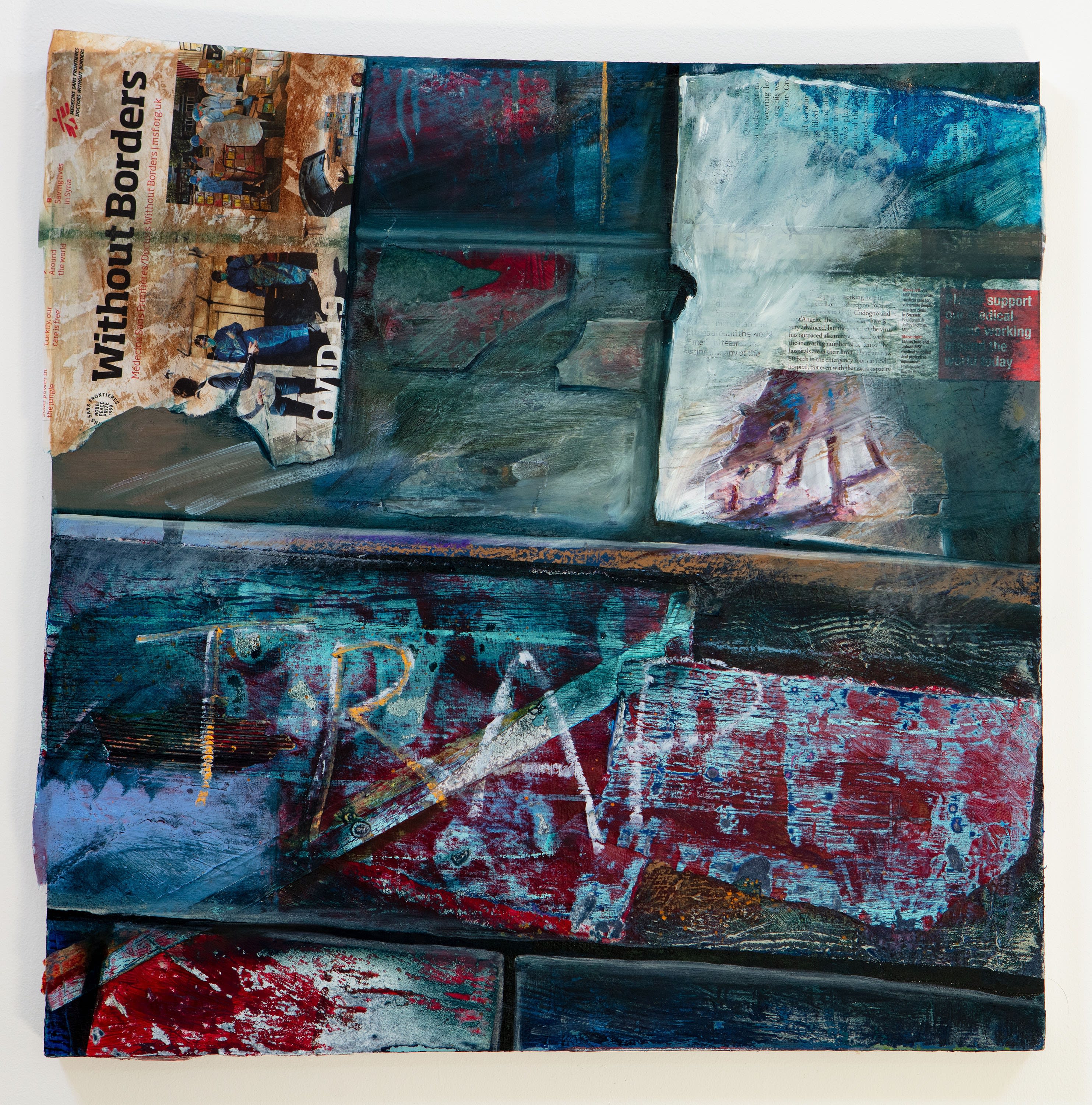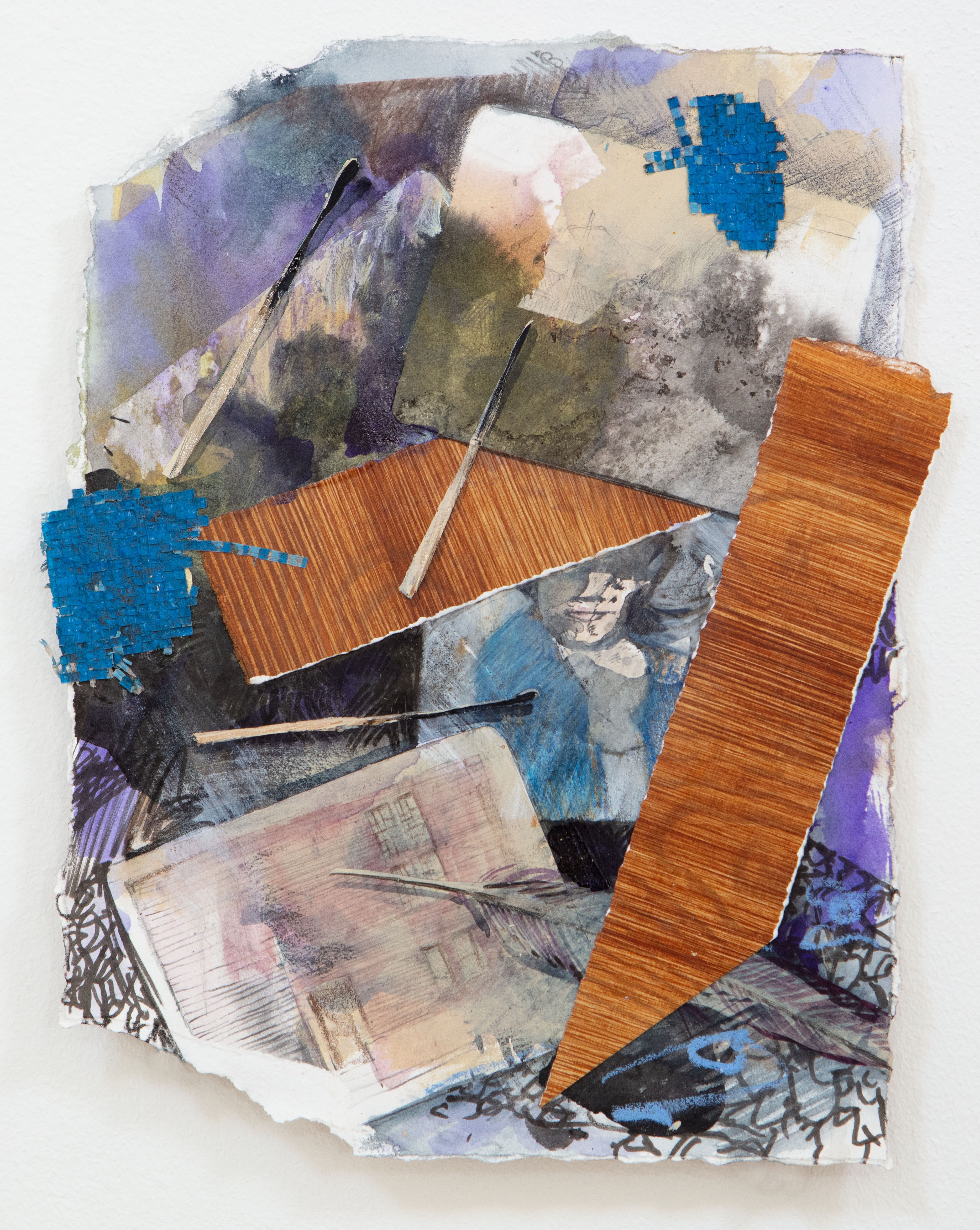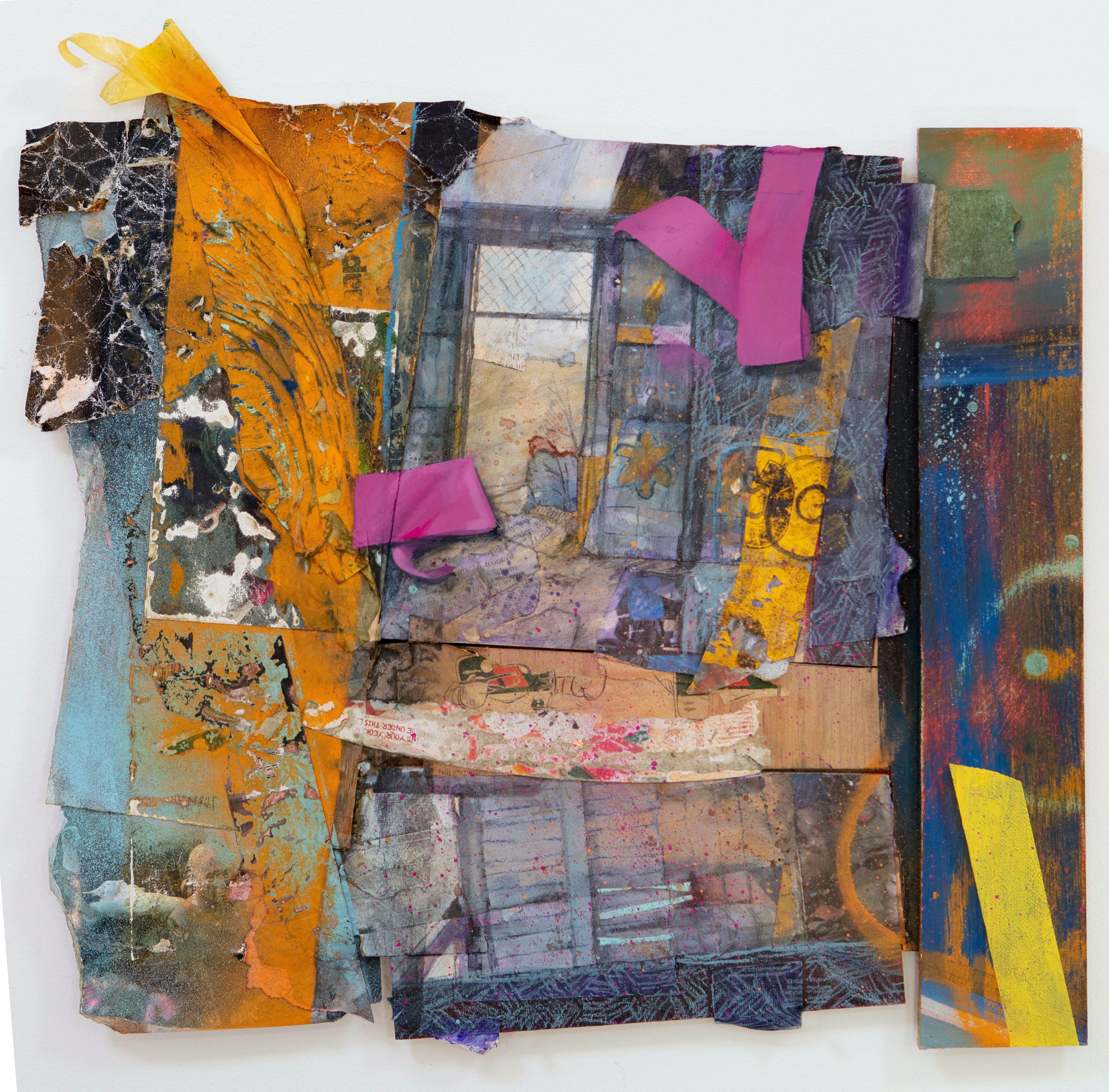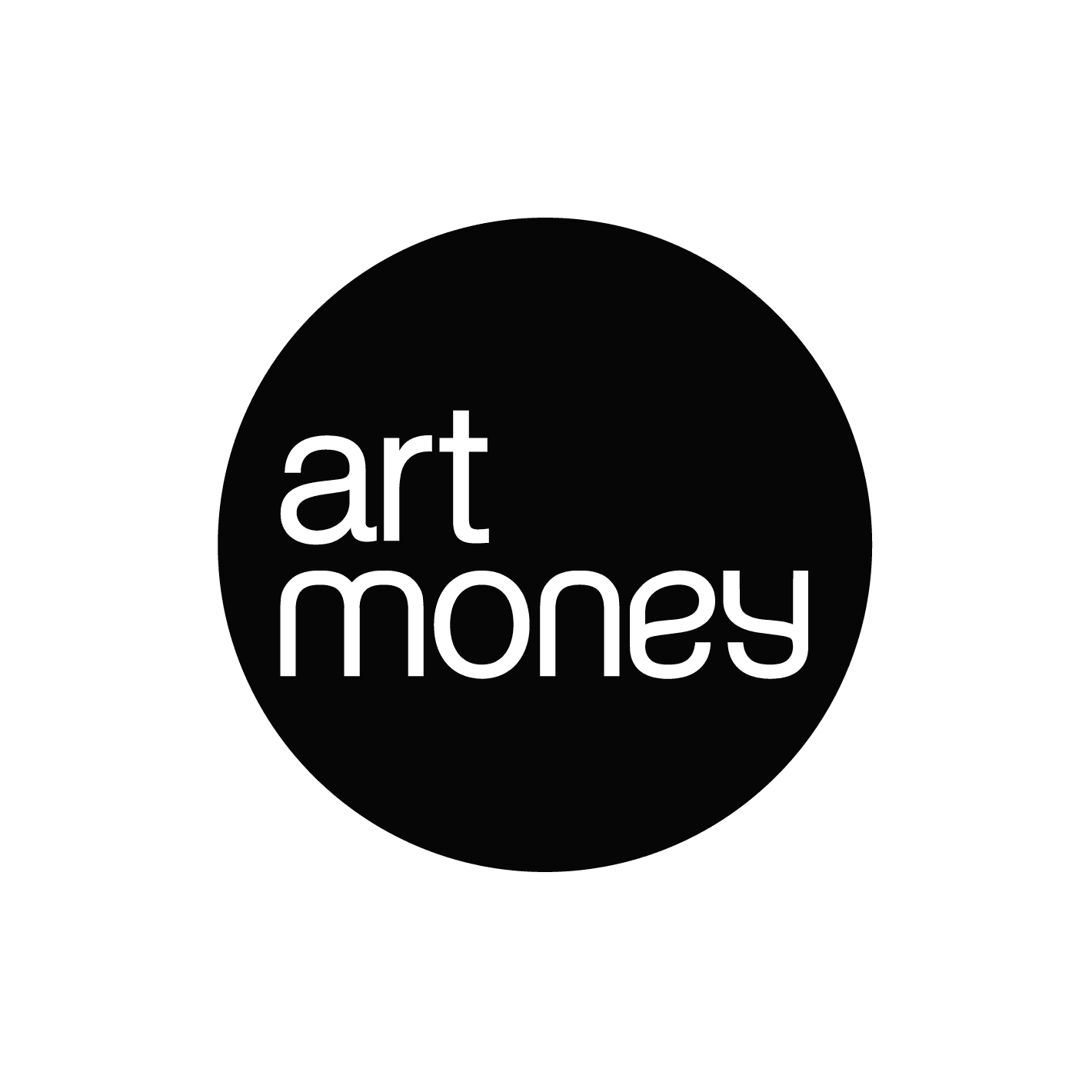
[CHARLEY PETERS]
Much of your work makes us question the act of looking and the nature of perception. The interplay between the reality of your paintings’ surfaces and the illusion of the image components within your work provoke a reconsideration of what we think we know we are observing through your skilled painted negotiation of the relationships between artifice and artefact. What is particularly fascinating in WITHOUT BORDERS is that you are now also challenging what we expect to see from you in an exhibition of your paintings. Alongside the meticulously made trompe l’oeil – or more specifically quodlibet – paintings, this show of recent work also includes a selection of collages that, although a longstanding part of your studio practice, are not as well-known and never before exhibited. This disruption of the known in WITHOUT BORDERS is something that I’d like us to discuss further in this conversation.
An Island Fairs Gently, 2020, oil and collage on board, 24.5x31.5cm
It feels like there is already a spirit of collage present in your painting. The invention of collage as a medium in the early twentieth century coincided with a growing cognizance of the role that mechanical reproduction played in all areas of life, including the visual arts. This is often reflected in the objects that you paint – postcards of historical artworks and graphic ephemera - reproductions of reproductions. Where zones of wooden panel are left bare in your paintings it is reminiscent of the areas of exposed canvas in collage works such as Picasso’s Still Life with Chair Caning (1912), the ‘tell’ of the artificiality of painting made explicit through a slow realisation of materiality. It’s interesting to consider how these concerns remain or indeed change in your collages. There is a sense of opposition between the two areas of your practice, the disparate compositional fragments that are implied in your paintings are sometimes actually present in your collages with more traces of real-world objects amongst the paint. There is a shift in the image/surface relationships from something more definitively illusionary in your painting to the less defined collage experience, in which the presence of found ephemera and paint is a material experience, rather than one used to describe something familiar from visual culture.
When you make the collaged works, are you consciously referring to the history or methodology of collage, or do you still consider them as paintings? How do you articulate the relationship between the two?
[ALASTAIR GORDON]
Collage has always been part of my working method, lurking in the dark recesses of my studio or hidden away in sketchbooks. Yet in recent months it has found its way into the paintings as well. I have come to see collage as a form of painting where papers, artefacts and residual materials are woven into the fabric of the painting from the start. In this way, it is less collage and more of an integrated approach to building up layers with a variety of media, collage being one. The paintings come together in a frenzy of mark making, intuition, deliberation, glue and oil paint.
There has always been a link between collage and quodlibet painting – that curious corner of European art history that has offered a fecundity of reference points for me in recent years. In this tradition objects are presented as pinned or taped to vertical surfaces such as a letter rack or wooden panel. On first glimpse they might even appear as collage. Yet my interest in collage goes beyond representation and the description of objects. Something else happens when the subject you paint is integrated into the fabric of the painting itself. This can be seen in Frank Bowling’s poured paintings or Joan Eardley’s Gorbals paintings where layers of paint are embedded with collage and found objects. In this way, Robert Rauschenberg, Barbara Rae and Kurt Schwitters also come to mind. The objects that we leave behind have always been a focus of my painting but now I’m also embedding the objects into the painting itself.
[CP]
Given that collage was a constant, albeit lesser known part of your practice, was there a definitive point at which painting and collage started to become less separate concerns in your studio?
[AG]
The two elements of collage and paint started coming together during my residency last year at the City and Guilds of London Art Schools. At the time, I was exploring certain decorative techniques commonly found in trompe l’oeil and illusionistic painting. I was looking into the history of wood graining and discovered paintings by Braque and Picasso that were new to me. Interestingly, you refer to Picasso’s Still Life With Chair Caning, in which we see that exchange between the printed image and the painted mark, that movement between artefact and artifice. Picasso painted onto an oil skin that he picked up in the local market - a kind of early vinyl print and something you’d use to line the inside of your drawers or shelves. I love how the image oscillates between fiction and reality, how it appears to fragment within itself. In the same year, Braque walked into a DIY shop and bought a roll of woodgrain, which he sliced up and collaged against his drawings of guitars, wine glasses and fruit. This created a dance between the illusion, representation and abstraction of wood surface. There seems to me something very intuitive about this analytical stage of Cubism, in which materials were chosen for their depictive qualities but also embodied something more instinctive and spontaneous. I’ve sensed that too as I’ve made these new works. At times, I will choose a collage element because it describes the properties of wood, stone or weathered plastic but more often it’s an intuitive decision, made in the moment. The ‘meaning’ doesn’t always emerge until later.
[CP]
I’d like us to talk more about how you make the collages, and more specifically their presence and/or role in the studio? For example, I’m interested in whether you would usually have collages in progress at the same time as paintings or whether they develop separately with a set of different concerns driving them. Are they studies or part of a phase of research, could we see a collage and then later, a painted version of it? Do they have a functionality beyond their formal value?

Forgotten Memories, 2020, acrylic and collage on paper mounted on board, 28 x 21cm
[AG]
Until recently the collages have been the reserve of my sketchbooks. I would very much consider them studies but this has changed since lockdown. I see them now as works in their own right and make drawings in preparation for the collages. The collage process can be markedly different to painting; it doesn’t take long to build up a surface and decisions can be made in the moment. If you get things wrong you can peel it off and start again, or simply paint over it. It’s an intuitive approach to image making that works well in a time when everything seems to change from day to day –. I am responding to the moment. As we are all adjusting constantly to life right now I feel that this is reflected in my painting and an idea can shift dramatically within the stroke of a brush. Collage works well in this particular moment as plans change and ideas evolve. There’s a fluidity of movement in collage that allows you to work in a constant state of flux
[CP]
The location of the work within this very distinct period is important, I’m sure that the impact of these unprecedented times on the way that artists have worked, and relate to their work, will become a documented point in art history. So much has happened recently to make us reconsider everything about what we do and how it relates to others and the world at large. Have you been aware of a connection to our contemporary lives while making the collages, or are they more autonomous objects than that?
[AG]
The collages often begin on location, so are rooted in a reality. I take papers and boards onto the streets and find my subject. Sketchbooks record the initial ideas but I often move to collage and painting quickly. A painting started on location might become the final work or it may inform a scaled-up version of the same painting. Some are completed there and then and you see the dust, sand and dirt of it all. Others are made over the course of several months. Some of these paintings were started two years ago in Calais when I worked with artists in Jungle Camp. It became a way of making a painting with whatever materials we had to hand and quite literally from the rubbish beneath our feet. I’ve been returning to old works in this way, tearing them up and re-imagining them for our current context. So they’re about human creativity and endeavour and how that gets subsumed in the detritus of oppressive systems. They’re about the debris of the moment, the rage and protest. They’re about my own experience as an artist in lockdown and what I’m learning about relinquishing control. They are concerned with my own anxiety for what’s happening in the world right now and the hope for better things to come. All of that finds its way into collage and paint. So they are reflective but without losing my formal concerns as a painter.
[CP]
Obviously, in the context of WITHOUT BORDERS we read the collages as definitive, resolved works – part of a wider presentation of recent practice. Is this a comfortable positioning for you, where the collages and paintings are of equally exhibitable value? And after years of the collages being a silent player in your work, why choose to show them now?
[AG]
This is such an interesting questions as I see these works as constantly in flux. Yet they are also complete and I do want to put them forward for scrutiny. When you work like this you are always in a state of doubt but that’s also what drives the painting forward. You see something that needs to change but in the process of correcting it, you create another problem that needs solving. And so it goes, like a dance or an ebb and flow with forces beyond your control.
I’m very excited about these new paintings. They mark a new direction for me but it’s been a long time coming and I’m ready. Why show them now? Because they have a greater urgency in this moment. They’re what I want to say about the mess and the frustration and the rage and the joy of it all; the contradictions of our time that collude and collide on the surface of the canvas.
Every artist needs a good gallerist and it was Vivienne at Aleph Contemporary who first saw potential in these collaged works and encouraged me to develop them further. I have been fortunate to have worked with various gallerists and curators in recent years who have opened a conversation about my work that has pushed things forward. This show is curated by a friend, John Silvis, whose steady hand and measured eye have complimented perfectly the fluctuating rhythms of my studio in the run up to the show.
[CP]
We have, until this point, mostly skirted around the most obvious conversation point at this time. Given the circumstances in which we all currently find ourselves, I do, however, feel compelled to ask you about lockdown, and how this unusual time in our lives has affected your working processes. I’m especially interested in the shift in temporality between the paintings and the collages, your paintings are precisely made and take time to view – it feels like the experience of both making and looking are slow and contemplative, with compositions that gradually lead the eye around different elements of painted information until we formulate a holistic visual experience. The collages feel more immediate – diverse pictorial elements are held closely together with the texture of paint and we see an image more rapidly. Could you talk about your lockdown studio practice and how you’ve adapted to working in what may be a more unsettled schedule or mindset?
[AG]
A few weeks prior to lockdown I wrote a question to myself in my sketchbook, “how would you paint if you didn’t have exhibition deadlines, collectors and people looking at what you have made?” Then lockdown happened and suddenly, like so many, I was thrown into exactly that strange situation. Having a studio on a piece of land behind my house has been an asset to me. Work space has not been my issue, but time has been more problematic. Currently my mornings are devoted to home-schooling my daughter Lilli, afternoons to my work with the charity Morphē Arts. My studio time has been the privilege of the evenings. After Lilli is in bed and the emails have stopped I can stay up late painting through the night. My wife, Anna, has also needed to work unusual hours during lockdown so we’re both quite sympathetic to each other’s recent unsociable hours.
Looking back to the first week or so of lockdown, I only had the energy to make small works and I made the same painting every day: a simple painting of three matches to represent three points in the day where I light the candle in my studio for prayer. From here, prayer became a more integral part of my painting practice and I started to call out to God as I worked, and over time my prayer life became more restless, agitated, and angry, and my painting reflected that tension. To me, painting is like speaking in tongues, that ancient language between God and human beings. You begin a painting with an idea of what you want to say but by the end something else has been released. Interpretation often comes later, if at all.
[CP]
You have just spoken about prayer, and its significance to your work and life, with great transparency. This kind of subjective honesty can sometimes be uncomfortable to artists when discussing their work – maybe it locates meaning or intention as something too connected to the self and leaves less room for others to access what is seen. It’s a complex and fascinating relationship. This question is related to this issue; can we locate your own subjectivity within the works in WITHOUT BORDERS? Where you are using ‘real’ artefacts as part of the collages – and perhaps even their representation in the paintings – is the work autobiographical? There’s an everydayness to some of material shown or referenced in your work, and also a process of democratisation where mass produced, easily accessible imagery stands in for the original, often untouchable artefact. Do the fragments of material that you present in your work represent you in any way, or are they chosen more objectively?

The Heart of Light, 2020, oil and collage on board, 53x60cm
[AG]
As I mentioned earlier, many of the collage elements are sourced on location. As such they are like found objects and serve as a direct connection to the subject I am painting. It might be a strip of paper that hangs from a billboard or a flyer left over from a street protest. Yet these works aren’t intended to be representational in a descriptive way. These residual artefacts are embedded into the surface of the painting and worked over with glazes and further collage, at times visible, and at times more obscured.
There are occasions when I paint a drop shadow or highlight on the collaged objects. Most often this is to integrate the collaged objects in with the painted artefacts or to balance the colour, composition or tone of the painting but of course this inverts the sense of illusion - a trompe l’oeil effect on a real object. It leaves the viewer in constant doubt about the veracity of these objects. In other places a collaged paper is clearly recognisable, but decontextualised or presented with new possibilities for how it could be read as an object. The works are autobiographical in so much as they are about what I am concerned with during lockdown but they are also about places I have visited in recent years that now have particular resonance with what we’re all going through at the moment.
[CP]
Given the unique timing of WITHOUT BORDERS and the decision to show usually unseen works, what have you learned about yourself as an artist while putting together the exhibition? The inclusion of the more raw, intuitively made collages maybe downplays your impressive painting technique, which is often at the forefront of how we relate to your practice. Has the opportunity to show a broader selection of work made you relocate yourself as a painter, or reconsider the concerns of your practice as a whole…and has this been a difficult experience when you have a well-established identity as an artist?
[AG]
As artists, I believe we have to keep responding to the moment, keep experimenting, listening, taking risks with our practice and breaking new ground. This doesn’t mean changing direction at every turn of the cultural tide but it does mean holding your practice lightly enough to make things new when the moment requires it.
For me, the last few weeks of lockdown have been the accumulation of many months wrestling and relinquishing control in the studio. Usually it takes me about six months to deconstruct my practice and put it back together again but lockdown has helped me complete this task more quickly and I feel all the more confident as a painter. I have been reminded of what I love about painting, and indeed why I went to art school in the first place. I have energy for painting that I never experienced before, at times waking early so I can get a few hours in at the studio before home-schooling my daughter. Even then she will come to the studio and we’re working on paintings at the same time. I’ve been learning to paint again through the eyes of a seven-year-old with all the wonder, frustration and empathy that brings, yet building on many years’ experience as a painter, throwing everything I know about painting into these works.
When one becomes known for a certain approach to painting it becomes all too easy to rest on your laurels. At best you become ‘the guy who does the masking tape’. At worst, you stop growing as an artist. I won’t say I’ll never return to making paintings of heightened realism (and I take enormous pleasure in making them) but these are the paintings that I need to make right now.
Charley Peters is a painter based in London. Her work has been recently exhibited at Saatchi Gallery, London Art Fair with Eagle Gallery, and Hauser & Wirth Showroom. She writes on concerns in contemporary painting.
Suggested Articles
-
"The Power of Trompe L’Oeil in Contemporary Art"
An exploration of trompe l’oeil techniques and their modern reinterpretations in contemporary art.
Read more on The Art Story -
"Collage as Contemporary Practice: Insights from Modern Artists"
A detailed look at how collage continues to influence contemporary art today.
Read more on Artsy -
"Blurring the Lines Between Painting and Collage"
Discover the interplay of mediums in the work of artists like Alastair Gordon and others.
Read more on Apollo Magazine -
"The Legacy of Cubism: Collage and Trompe L’Oeil in the 21st Century"
Insights into how Picasso and Braque’s innovations influence modern artistic practices.
Read more on Tate -
"Art in Lockdown: Creativity in Confinement"
Examining how artists adapted their practices during the COVID-19 lockdown.
Read more on The Art Newspaper -
"Frank Bowling’s Embedded Collage: Layers of Meaning"
A look at how Frank Bowling’s use of embedded materials parallels Gordon’s approach.
Read more on Hauser & Wirth

